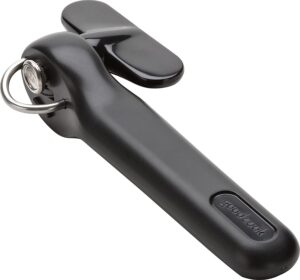I first came across a safety can opener about 20 years ago. I couldn’t figure it out. How did you use it? It didn’t have any blades or anything to puncture the tin lid. I was told to just use it like normal and it would work, but when I was turning the crank it felt like nothing was happening. It was too easy to turn, perhaps I didn’t have it on correctly?
I was told it was done, but the can appeared unchanged. How could this be a better design if it couldn’t even open the can after rotating 360 degrees? How wrong I was.
The lid was completely free from the can and could be lifted easily off and there were no sharp edges to be found! The lid could even go back on the can to keep it in the fridge if I couldn’t manage to eat a family size condensed tomato soup by myself in one sitting. I was instantly converted. This was obviously a better design for the future.
So why has the safety can opener which has been around for 30+ years now not completely replaced the old, familiar design that dominates the market today?
| Attributes | Traditional Can Opener | Safety Can Opener |
|---|---|---|
| Easy to understand | Yes | No |
| Easy to use | Sometimes | Yes |
| Feedback – Haptic, Auditory, Visual, & Olfactory | Yes | No |
| Good for people with disabilities | No | Yes |
| Safe | No | Yes |
| Can reuse contents in can? | No | Yes |
| Cost | Extremely cheap | Cheap |
| Will can lid cut hole in garbage bag and leak garbage water everywhere? | Yes | No |
The Comparative Dynamics
In the clash of the traditional vs. the safety can opener, I believe the one aspect that tips the scale in favor of the traditional is its familiarity. This familiarity is not only due to its longstanding presence but also the feedback it provides during use. The traditional can opener, with its cutting through brute force, gives immediate feedback, making the user aware that the can is indeed being opened. The resistance one feels while turning the handle, the sound of metal cutting metal, the sight of the lid being penetrated, and the aroma of the can’s contents wafting out, all contribute to a sensory confirmation of the task’s completion.
Safety can openers, on the other hand, provide a seamless, almost effortless operation. This lack of sensory feedback can lead to confusion & skepticism making the the user question the effectiveness of the tool. This skepticism can remain even after a successful opening due to the lack of understanding of how it works. I’m sure there’s a fancy word for this behavior.
Accessibility and Safety
When it comes to accessibility and safety, safety can openers win the prize. The design is particularly beneficial for people with disabilities, such as arthritis, who may struggle with the manual pressure and the twisting motion required by traditional openers. Additionally, the safety feature that eliminates sharp edges is a significant advantage, particularly in households with careless children.
The Cost Factor

Cost is another factor that plays into the market dynamics. While the price difference between safety and traditional can openers is not much, traditional openers are typically more affordable and definitely more accessible. You don’t see safety openers stocked in very many places. In fact, I’d be willing to bet that you may have never seen one in your life, and if you did you probably thought it looked weird and moved on. For people that just want something that’s “good enough” they’ll usually choose the traditional opener.
Feedback
Consider the rise of engine sound enhancement in electric cars. The car pumps fake audio through the speakers to make the user feel like the engine is revving and changing as the driver navigates the road. Without that aural feedback drivers didn’t feel like they were driving. Something was off.
I believe this is a major obstacle that needs to be overcome. Does everything need feedback? It sure seems like it. Imagine pressing a button and not hearing that satisfying click of confirmation. Did you even press the button correctly? There’s a story I read once about a designer for the Sony Walkman (or maybe it was a VCR?) working tirelessly to get the right feedback sounds to occur as a user inserted a cassette and pressed play. Humans need this kind of feedback to feel connected. You take that away and the experience feels unfulfilling.
Is feedback essential to product design? I think so, but I won’t die on that hill. I just haven’t thought of a great product that lacks feedback yet.
Safety Can Opener 3000
I propose a new safety can opener that makes 2 sounds. A click as the device is attached to a can, and another when it’s completed the job. That’s it. This could be done in many ways. Perhaps a tiny enclosed magnet that attaches to the lid for the initial click? It doesn’t need to be a big production, just something to let the user know it’s working.
This will provide necessary feedback to the user, but I think more education needs to occur as well. I’m not talking about classes on how a safety can opener is better in every way. It needs more desirable product packaging. Differentiators need to be clear and the new use cases must be presented in a way that at a glance a shopper will think twice about buying another nasty, old, dangerous, blood-thirsty can opener.


